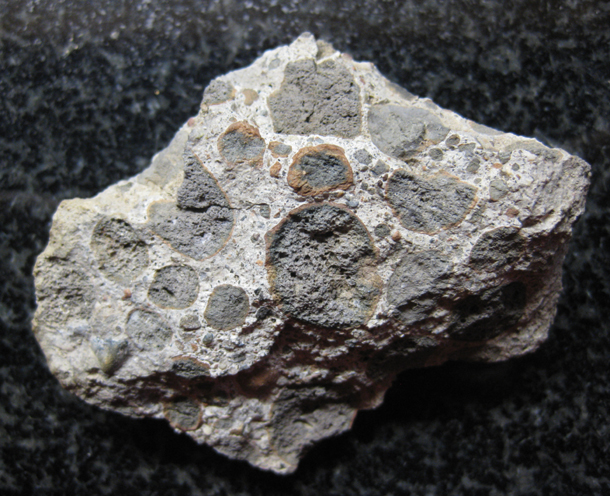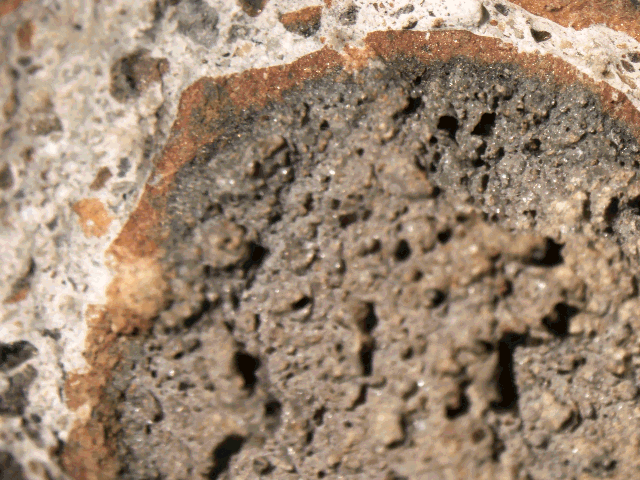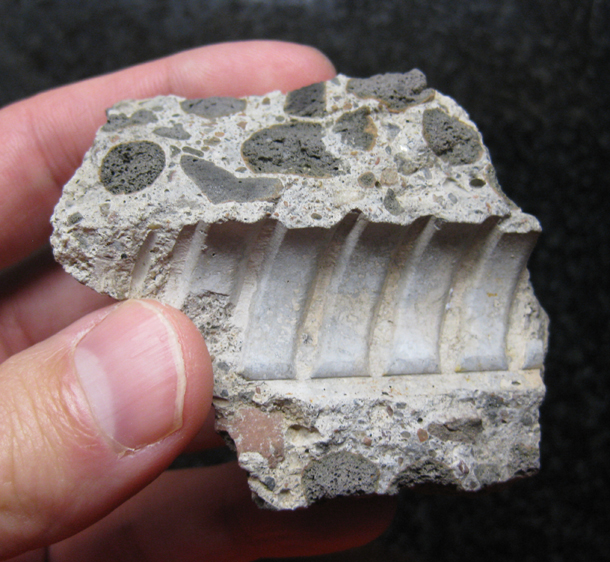When I was out in California in October 2009, about the same time that Garry Hayes passed me on the highway heading up to Yosemite while I was headed down towards the Modesto Airport, I pulled over to check out some rock exposures on the side of the road. This was near the Don Pedro Reservoir (right about here). While standing there, my attention was caught by a strange looking “rock” in a ~2 m wide hole at the side of the road.
Here’s what it looks like:

As you can see, it shows a “malted milk ball” (Whopper) texture, with dark spherules full of vesicles sitting in a light-colored, poorly-sorted matrix. The “orbs” have brown rims that are far less vesicular.
Here’s a close-up of the edge of the big central orb, shown with my patented* “animated focal plane” GIF technology.

Field of view is about 1 cm. The dark little vesicular orbs and ellipsoids vary in size between 1 and 15 mm (long axis) are distributed in a matrix that looks suspiciously like concrete. These “Whoppers” have orangey brown (oxidized?) rinds.
What’s going on here?
Is this even natural? If you flip it over, you see this:

That looks a lot like an external mold of the flexible spiral-bound housing used to run cables through. So I guess it is concrete …of a kind I’ve never seen before. Where do the little orbs come from? Are they natural, only to be incorporated into an artificial “rock” (urbanite)? Or are they also manufactured?
Has anyone run into these vesicular “malt balls” in concrete before? Do tell!
________________________________
* Not really.

That’s a great idea varying the camera’s aperture and animating the results. I’ve taken macroshots of rocks and have had no end in frustration trying to get everything in focus. I’ll have to try this next time.
I’ve never seen concrete like that before in California.. if that is what it is!
it looks like a lightweight concrete that used slag as its coarse aggregate. the mold is of rebar.
It is structural lightweight concrete. It is structural because of the presence of rebar, as indicated by the mold of a rebar. The aggregate, both coarse (>#4 sieve), and fine (<#4 sieve), is expanded (bloated) clay or possibly shale. It is probably clay because the particles are rounded and have a uniform distribution of expansion bubbles. The brown rims are due to oxidation in the rotary kiln used to bloat the material. Bloating occurs in the 1,900 to 2,200 degree F range, depending upon the material. Bloating occurs because of the release of gas from a component in the clay, shale, or slate. This could be finely divided organic matter, pyrite or marcasite, siderite, calcite, gypsum, etc.
The source for the lightweight aggregate was most likely the Porta Costa plant in Porta Costa, California. It was most recently owned by TXI, who closed the plant in 2005.
Steve Stokowski
Concrete Petrographer
Wow — super cool details! Thanks, Steve!
Some time ago I found a rock like this one. In Poland.